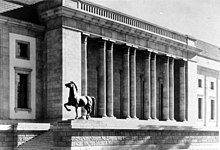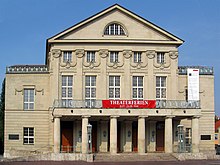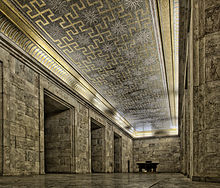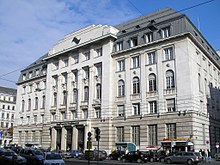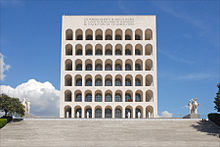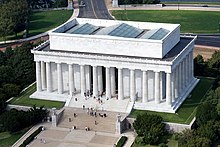Neoclassicism (visual arts)
Neoclassicism (or Neoclassicism ) is called the last formally uniform style of the fine arts and architecture of historicism in the German-speaking cultural area in the early 20th century in German- speaking art history . The eclectic style is also considered the beginning of modernity . The term modernist classicism is also used for the architectural style of the 1930s .
In the painting and sculpture of Carlo Carrà , Giorgio de Chirico , Adolf von Hildebrand , Aristide Maillol , Pablo Picasso and Ignatius Taschner, neoclassical influences can be seen.
In the architecture of Neoclassicism is the ideal and formal contrast to the simultaneously evolving classical modernism , while the ornamentation of architectural styles Jugendstil (art nouveau) and Liberty withdraws. It is, together with the Heimatschutz style , part of the general traditionalist currents at the beginning of the 20th century, which had the goal of maintaining old (pre-industrial) values and structures. Ideas from Greek and Roman antiquity , baroque and classicism , and classicist elements of the Renaissance ( Andrea Palladio ) are taken up again, which are reflected in the monumental appearance , in the arrangement of columns , in the spatial arrangement (right-angled floor plans , symmetry ) and in the showing tectonic structure .
term
The term is used differently in German art history than in other European languages and describes the style developed in the 20th century, which is called neo- classicism in contrast to the classicism of the late 18th and early 19th centuries .
In contrast to the German usage, the term classicism is more broadly defined in English, French and other European languages and describes style phenomena that already occurred during the Renaissance ( e.g. Palladianism ) and the Baroque and are characterized by the fact that they are based on the architecture of the Orient Greco-Roman antiquity ( classical ). The later the Rococo following renewed devotion to ancient architecture models (the first under the name of the German now Classicism is known) is therefore in French as néoclassicisme , English as Neoclassicism and Italian as neoclassicismo referred.
The neoclassical architecture is in English with architecture New Classical and Italian with Nuova architettura classica be translated.
Development in architecture
In the field of architecture, neoclassicism is a style name and collective term for a large number of currents of the 20th century with different regional characteristics that refer to ancient or classical models.
Origin around 1900
The beginnings of neoclassicism in the USA can be dated from 1893 in the wake of the “ World's Columbian Exposition ” in Chicago. They are based on the tradition of the École des Beaux-Arts in Paris, which shaped all official building in the USA in the following decades. In contrast to the USA, the appearance of neoclassicism in Germany around 1908 is to be understood as a reaction to Art Nouveau and certain first tendencies towards objectivity in the area of the Deutscher Werkbund . It was some of the most outstanding representatives of Art Nouveau, such as Peter Behrens and Joseph Maria Olbrich , who turned to classical forms in the years before and after the First World War .
Connection between neoclassicism and modernity (from 1920s)
Since the 1920s, neoclassicism in German-speaking countries has been in competition with expressionism and finally with the functionalist renewal movement of the Bauhaus and the New Objectivity . Despite all the rivalry for the radical will to innovate of the Bauhaus, certain similarities can be observed in neoclassicism in Germany, France and Scandinavia in the tendency towards formal simplification, which is particularly evident in the work of architects such as Heinrich Tessenow , Theodor Fischer and Gunnar Asplund . German neoclassicism and its related expressions of the 1920s and 30s in Europe are characterized by the reduction or even omission of the decorum , which is why smooth transitions to the appearance of the New Objectivity can often be observed, e.g. B. at the Palais de Tokyo in Paris. In France there were also overlaps with Art Deco from the 1920s to 1940s.
Dominance architecture of totalitarian regimes
At the beginning of the 20th century, neoclassicism appeared in many countries in Europe and America, initially regardless of the respective form of government, and thus gained public recognition in many democratically governed countries. In the course of the 1930s, however, the new totalitarian regimes in Germany, Italy and the Soviet Union elevated it to a representative, monumental state style as part of their attempts at art-political control and propagandistic self-portrayal. Neoclassicism remained binding for the Soviet sphere of influence until well into the 1950s and found its form as socialist neoclassicism , in the Third Reich as typical National Socialist architecture .
This political appropriation of neoclassicism by totalitarian regimes led in the Federal Republic of Germany after the collapse of fascism and also against the background of the closure of the Bauhaus by the National Socialists to a symbolic devaluation through the identification of classical forms with totalitarian architecture . The general ostracism increased in post-war Germany also in the effort to rehabilitate the Bauhaus, which was now considered to represent a progressive and democratic culture. On the other hand, neoclassicism, insofar as it had not approximated classical modernism by renouncing decorum, was often judged to be the epitome of a backward-looking, authoritarian and the individual intimidating architectural conception. Similar to the works of historicism, his buildings were considered epigonal, outdated or even reactionary in the context of art historical progress narratives.
Discussion in recent times
Although recent art historical research has been able to relativize the symbolic devaluation of neoclassicism with reference to the fascist variant of classical modernism in Italy in the 1930s and at the same time makes the symbolic counter-model of a progressive and democratic Bauhaus style appear more and more questionable, the discrediting of neoclassicism in Germany is ongoing Topicality. For example, in the bitter public architectural dispute of the 1990s about the reconstruction of Berlin after reunification, the proponents of a massive and monumental-looking architecture were suspected of being symbolically linked to the architectural forms of fascism. Even if such debates have lost their polemical sharpness in the course of the last decade and a number of prominent reconstructions, such as the Hotel Adlon in Berlin, are now using classicist forms, neoclassicism in the public debate is still the accusation of political and artistic backwardness exposed. At German architecture schools, the classic canon of forms is not part of the design theory and is only dealt with in the context of the subjects of building history and monument preservation .
Examples of neoclassical buildings
German Empire and Weimar Republic
- Kurhaus Wiesbaden , Friedrich von Thiersch , 1905-07
- German National Theater in Weimar, Max Littmann , 1907/08
- Meininger State Theater , Karl Behlert , 1908/09
- Linden Museum in Stuttgart, Georg Eser, Bihl & Woltz, 1909–11
- Theater Hagen , Ernst Vetterlein , 1910–11
- In Berlin the Zollernhof (Kurt Berndt, 1910/11) and the Stadtbad Neukölln ( Reinhold Kiehl and Heinrich Best, 1912-14)
- Theater Duisburg , Martin Dülfer , 1911/12
- Stadthalle Hannover , Paul Bonatz , Friedrich Eugen Scholer and Michael Kott, 1911-14
- In Düsseldorf the Mannesmann administration ( Peter Behrens , 1912) and the Carsch House ( Otto Engler , 1913–15)
- The town hall in Herne by architect Wilhelm Kreis , 1912.
- in Cologne the festival hall of the Werkbund exhibition, 1914 (not preserved)
- German Hygiene Museum in Dresden, Wilhelm Kreis , 1928–30
National Socialist Neoclassicism
- Berlin : Olympiastadion ( Werner March , 1934–36), former Reich Aviation Ministry (today Detlev-Rohwedder-Haus , architect Ernst Sagebiel , 1935/36), Tempelhof Airport (Sagebiel, 1936–41), New Reich Chancellery ( Albert Speer , 1937–39 , not preserved), Italian Embassy ( Friedrich Hetzelt , 1939–41)
- Nuremberg : Nazi party rally grounds with congress hall ( Ludwig and Franz Ruff , from 1934)
- Munich : House of Art ( Paul Ludwig Troost , 1933–37); on Königsplatz the Führerbau (today the University of Music and Theater), administration building of the NSDAP (today the Munich House of Cultural Institutes ), temple of honor for the fallen of the movement (all Troost, 1933–37); Reichszeugmeisterei (Paul Hofer and Karl Johann Fischer, 1935–37)
- Anhaltisches Theater in Dessau, 1937/38
- Federal Social Court in Kassel (Ernst Wendel, 1936–38)
- Weimar the Gauforum ( Hermann Giesler , 1937–)
- Saarbrücken : Saarland State Theater , Paul Baumgarten , 1937/38; Reichsbahndirektion Saarbrücken, 1938 by PA Behringer
- Bridgehead building in Linz , Roderich Fick , 1940–43
Austria
- Haus am Schottentor , Ernst Gotthilf and Alexander Neumann , 1910–12
- Hotel Bristol Vienna , Ladislaus Fiedler and Pietro Palumbo, 1911
- Park Hyatt Vienna, formerly Länderbankzentrale , Ernst Gotthilf and Alexander Neumann, 1913–15
- Villa Primavesi Vienna, Josef Hoffmann , 1913–15
- Austrian house for the Cologne Werkbund exhibition , Josef Hoffmann, 1914
- Bank Austria Kunstforum in Vienna, Ernst Gotthilf and Alexander Neumann, 1914–21
- Austrian National Bank , Rudolf Eisler and Ferdinand Glaser , 1923–25
Bulgaria
- Buildings by the architect Georgi Owtscharow , z. B. Town hall in Burgas (1936), Georgi Dimitrov mausoleum (1949)
France
- Paris: Palais de Chaillot (Louis-Hippolyte Boileau, Léon Azème and Jacques Carlu, 1937), Palais de Tokyo (Jean-Claude Dondel, André Aubert, Paul Viard and Marcel Dastugue, 1937)
Italy
Neoclassicism was also the preferred architectural style of the Italian fascists.
- Rome: Foro Italico ( Enrico Del Debbio and Luigi Moretti , 1928–38), main building of the La Sapienza University ( Marcello Piacentini , 1932–35)
- With the Esposizione Universale di Roma (EUR) there is a whole district in the south of Rome that is characterized by fascist neoclassicism, u. a. Palazzo della Civiltà Italiana (Ernesto Bruno La Padula, Giovanni Guerrini and Mario Romano, 1938–43) and Basilica of St. Peter and Paul (Arnaldo Foschini, 1939–1955)
- Bolzano: Victory Monument , Marcello Piacentini, 1926–28
Romania
- Buildings by the architect Duiliu Marcu in Bucharest, especially the Victoria Palace (1937–44)
Russia
- Imperial German Embassy in Saint Petersburg, Peter Behrens , 1912
- The police headquarters of Copenhagen in Denmark (1918–1924), design: Hack Kampmann with Holger Alfred Jacobsen , Hans Jørgen Kampmann and Aage Rafn
- The Reichstag building (eduskuntatalo) by Johan Sigfrid Sirén in Helsinki (1931)
- in Stockholm the city library and the crematorium.
Turkey

- Ankara: Ataturk's mausoleum, Anıtkabir (Emin Onat and Orhan Arda, 1944–53) and the current parliament building ( Clemens Holzmeister , 1938–60)
United States
- Washington DC: Washington Union Station ( Daniel Burnham & Co., 1903-07); Lincoln Memorial (Henry Bacon, 1912-22); Marriner S. Eccles Federal Reserve Board Building ( Paul Philippe Cret , 1937); National Gallery of Art ( John Russell Pope , 1937–41)
- New York: Hall of Fame for Great Americans (1901); Equitable Building (Ernest R. Graham, 1913-15)
- Detroit: Michigan Central Station (Warren & Wetmore, 1910-13)
- Philadelphia: Philadelphia Museum of Art ( Horace Trumbauer & Co., 1919-28); 30th Street Station (Graham, Anderson, Probst & White, 1929–33)
Socialist neoclassicism

- former Soviet Union
- The Palace of the Soviets , joint work of the architects Boris Iofan and Vladimir Shchuko , 1932, but construction was discontinued in 1941 and never completed
- In St. Petersburg the House of the Soviets , Noi Trozki , 1936–41
- in Kiev the Presidential Office of Ukraine (formerly the Central Committee of the Communist Party, 1936–39)
- in Moscow the Seven Sisters (1947–57), including the main building of Lomonossow University
- former DDR
- Eisenhüttenstadt emerged from 1950 as a planned town in the style of socialist classicism
- in Berlin the Karl-Marx-Allee (eastern section, Egon Hartmann , Hermann Henselmann , Richard Paulick , Hanns Hopp , 1951–53); former district heating plant at Ostbahnhof (today Technoklub Berghain , 1953/53)
- in Leipzig the ring development ( Rudolf Rohrer , 1953–55), the German University for Physical Culture (today Sports Science Faculty, Hanns Hopp and Kunz Nierade , 1952–57) and the opera house (Kunz Nierade and Kurt Hemmerling , 1954–60)
- in Dresden the development on the Altmarkt , Herbert Schneider and Johannes Rascher , 1953–56
- in Magdeburg numerous central inner city buildings, z. B. in Ernst-Reuter-Allee (Johannes Kramer)
- Poland
- in Warsaw the Palace of Culture , Lew Rudnew , 1952–55
- Romania
- in Bucharest the Parliament Palace , Anca Petrescu , 1983–89
literature
- Peter Noever (Ed.): Tyranny of the beautiful. Stalin era architecture. MAK, Vienna 1994, ISBN 3-7913-1340-1 .
- Herbert Nicolaus, Alexander Obeth: The Stalinallee. History of a German street. Verlag für Bauwesen, Berlin 1997, ISBN 3-345-00605-7 .
- Frank-Bertolt Raith: The heroic style. Studies on architecture at the end of the Weimar Republic. Verlag für Bauwesen, Berlin 1997, ISBN 3-345-00606-5 .
- Birk Engmann: Building for Eternity. Monumental architecture of the twentieth century and urban planning in Leipzig in the fifties. Sax-Verlag, Beucha 2006, ISBN 3-934544-81-9 .
- Roman Hillmann: The first post-war modernity. Aesthetics and perception of West German architecture 1945–63. Michael Imhof Verlag, Petersberg 2011, ISBN 3865685897
- Hans Jürgen Reichhardt, Wolfgang Schächen: From Berlin to Germania. About the destruction of the "Imperial Capital" by Albert Speer's redesign plans. Transit Buchverlag, 11th edition 2008, Berlin 1998, ISBN 388747127X


